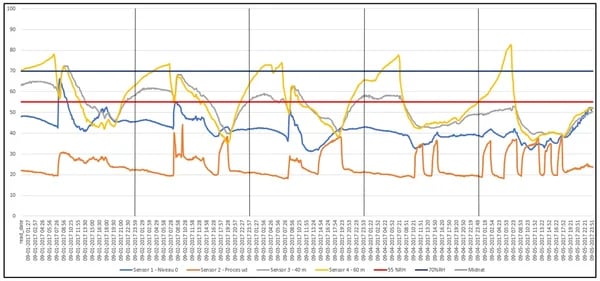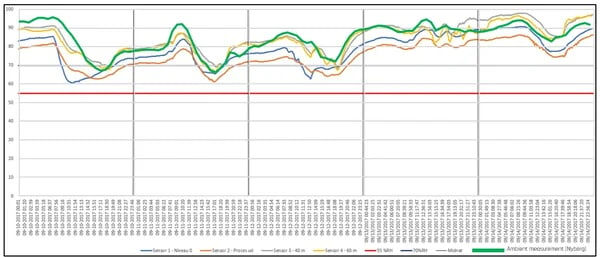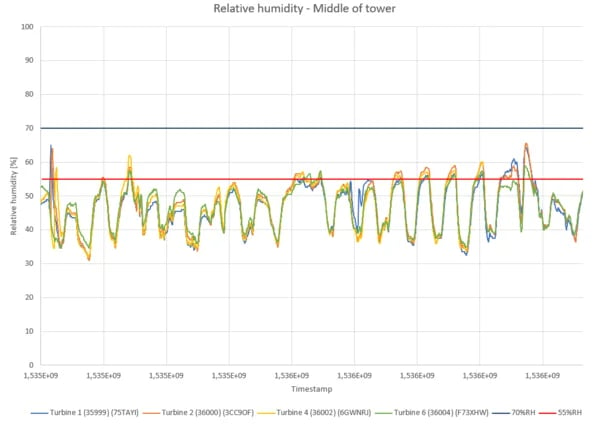In 2017, Cotes was commissioned to investigate and test the air quality inside wind turbines in an operating offshore wind farm in Scandinavia and recommend the best dry-air strategy. Mould issues had been identified in the towers and a non-Cotes dehumidification solution was not performing well. In fact, it was constantly breaking down and requiring service technicians to be sent out. Our team of experts was brought in to consult on the best dry-air solution. The result led to Cotes retrofitting the entire wind farm with Cotes adsorption dehumidifiers.
Collecting humidity and temperature data
In order to advise on the best dry-air strategy for our clients (a large wind turbine manufacturer and a windfarm owner), Cotes measured and collected humidity levels in a fleet of offshore wind turbines located in Scandinavia from August through November 2017. During this period, a Cotes solution for moisture protection of the towers was installed and compared with the OEM dehumidification solution (non-Cotes dehumidification solution), as well as a turbine with no dehumidification system at all.
Measurement sensors were placed in four different locations inside the towers of the turbines to measure temperature and humidity every five minutes. These sensors were placed in the following locations:
- Sensor 1: Level 0 (measurements outside the wind turbine)
- Sensor 2: Dry-air hose from dehumidifier (operating pattern)
- Sensor 3: 40 meters height
- Sensor 4: 60 meters height
Dry-air solution performance data
Our team collected extensive measurement data from this study. Below, we share results from selected times representative of the given operation. Relative Humidity (RH) is the critical value in this study.
The diagrams indicate a red horizontal line at 55% RH to mark the maximum recommended humidity. The limit for the growth of mould is marked with a horizontal dark blue line. In addition, vertical black lines are indicated at midnight. These are intended to make comparison easier across the charts. The limit values on the % RH axis are also 0 and 100% on all diagrams.
The following conditions are compared in this case study:
- Operation with a non-Cotes dehumidification solution
- No protection
- Cotes CWO26 (overpressure and desalter)
Operating Condition #1
Going with the non-Cotes dehumidification solution
The non-Cotes dehumidifier uses a traditional 4-hole solution.
The graph shows how limited the distribution of the dry air is. It is documented that the humidity rises, the higher you go in the tower. This solution requires extensive (expensive) air ducting to distribute the air throughout the wind turbine because it creates a neutral pressure inside the structure. Why a non-Cotes dehumidification solution is not the right solution.

Sensor 1: Level 0 (measurements outside the wind turbine) Sensor 2: Dry-air hose from dehumidifier (operating pattern) Sensor 3: 40 meters height Sensor 4: 60 meters height
It can also be seen that the accuracy at the top of the tower exceeds the 55% RH limit daily. This is even though the dehumidifier appears to be in operation at these times (the dehumidifier's operation is represented by the orange curve).
Operating Condition #2
No humidity protection
Since the non-Cotes dehumidifier was out of service several times, we could observe what is happening in the tower without a dehumidifier. This graph shows ambient and inside relative humidity and is a good example of how much humidity is present in your wind turbine without a dry-air strategy. Create your own dry-air strategy.

Sensor 1: Level 0 (measurements outside the wind turbine) Sensor 2: Dry-air hose from dehumidifier (operating pattern) Sensor 3: 40 meters height Sensor 4: 60 meters height
The green line is an overlay of external weather data for the location from the Danish National Weather Service; (https://www.dmi.dk/vejrarkiv/)
The relative humidity is very much the same throughout the entire height of the tower, and the climate is almost the same inside the turbine as outside – and well above the recommended level of 55% RH.
Operating Condition #3
Cotes CWO26 (overpressure solution where an internal duct system is not necessary)
Apart from being easy to install the Cotes dry-air solution used was the CWO26 patented overpressure system. Create your own dry-air strategy. Relative humidity measured at 60-meters tower height was well below 55% RH. The data below is from 4 different turbines. We saw constant measurements of RH through the turbine which is why we did not include each individual sensor.

The data shows:
- The CWO26 creates a dry (45-55% RH) and protective (salt-free) atmosphere
- The CWO26 is easy to install and fits the existing inlets and outlets through the tower wall
- No extra ducting is needed
- Consistent performance of CWO26 in different turbines from the same location.
Conclusion
To create a sound and robust dehumidification solution in offshore turbines, the climatic conditions at sea must be given serious consideration. Otherwise, mould issues, that are expensive to resolve, are likely to occur. If you have mould in your turbine you also have a high probability and risk of condensation which leads to corrosion, and electrical failures.
Cotes recommends the combined desalination and dehumidifier because:
- Easy installation for manufacturing or retrofit – there is no need for ducting through the tower.
- Reliable and energy-efficient
- A high level of safety, as positive pressure with dry and salt-free air, is created through the tower, which also protects the top of the tower.
- Can be used with existing air inlets and outlets in the tower wall.
-1.webp?width=280&height=396&name=20210609%20Productimage%20CWO26%20-%20Steel%20overlay-min%20(1)-1.webp)
